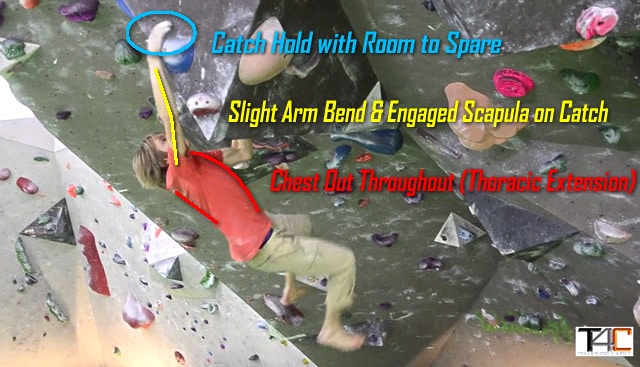How to “Campus Boulder” with Proper Technique
Boulder campusing is a popular indoor training exercise among advanced climbers—it’s also a heck of a lot of fun, if you’re strong enough to do it right! The goal is to ascend a section of overhanging wall by simply climbing hand-over-hand with no aid from the feet. This exercise is similar to campus board laddering, and the same injury warnings apply: Campusing with straight-arm “catches”, shrugged shoulders, and a caved-in chest will get you injured, likely sooner than later.
Boulder Campusing to Train Maximum Power
Training max power is best done on a campus board, where you can focus on doing straight-forward, high speed movements near your very limit. That said, if you want to train maximal power on an overhanging boulder, you should select a three- to five-move route with medium- to large-size holds that you can engage with an open-hand or open-crimp grip. The perfect route would be void of small or tweaky holds, awkward arm positions, and reaches that are so long you can’t help but use (dangerous) straight-arm positions. Climb fast! If it takes you more than 6 to 8 seconds to ascend the sequence, then the moves are too big and powerful for you—select an easier problem, or better yet, go use the campus board instead.
Do three campus ascents of the boulder with 3 to 5 minutes of rest in between. Super strong climbers can do three ascents of three different problems. Either way, always rest completely between ascents—remind yourself that “quality over quantity” is the training secret to developing higher power!
Boulder Campusing for Building Power Endurance
Whereas maximum power is developed by brief bursts (<10 seconds) of near-limit, high-speed movements (like campus boarding 1-4-7-10), power endurance must be trained with a rapid succession of near-maximal bursts of power for a duration of between 20 seconds and 60 seconds. On a campus board, you could simply “campus ladder” up and down (1-3-5-7-9-9-7-5-3-1 and repeat) for around 45 seconds—boring, but effective. Much more interesting and fun is campusing a long section of overhanging wall for 10 to 20 hand moves (15 to 35 seconds). Even using juggy hand holds, this is a very advanced training method that requires good kinesthetic awareness of scapular positioning and, of course, strong enough scapular stabilizer and rotator cuff muscles to maintain proper form throughout the ascent.
What does proper form look like? Check out my friend, Alex, casually campusing a V-hard 16-move boulder at Cafe Kraft!
Safety Notes & Training Tips:
- If you can’t do a solid one-arm pull-up, then you probably should stick to using a campus board for power training.
- If you aren’t doing targeted training of your scapular stabilizers and rotator cuff (Scapular Pull-ups, Internal and External Rotation, Ys &Ts on a sling trainer, etc.), then BEGIN!
- Use of good campusing technique (as detailed on the photo above) is essential—don’t add your name to the long list of climbers who have wrecked their shoulders (often requiring surgery) by overzealous campus training with poor technique, due to insufficient base strength and/or campusing in a state of high fatigue.
- Have a friend shoot a short video of your boulder campusing to self-assess the quality of your technique. Favor boulders with fewer moves and short reaches to ensure use of good campus technique.
Copyright © 2000–2017 Eric J. Hörst | All Rights Reserved.


